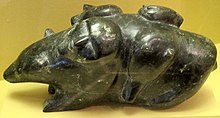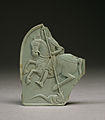
Marble is a metamorphic rock consisting of carbonate minerals (most commonly calcite (CaCO3) or dolomite (CaMg(CO3)2)) that have recrystallized under the influence of heat and pressure. It has a crystalline texture, and is typically not foliated (layered), although there are exceptions.

Talc, or talcum, is a clay mineral composed of hydrated magnesium silicate, with the chemical formula Mg3Si4O10(OH)2. Talc in powdered form, often combined with corn starch, is used as baby powder. This mineral is used as a thickening agent and lubricant. It is an ingredient in ceramics, paints, and roofing material. It is a main ingredient in many cosmetics. It occurs as foliated to fibrous masses, and in an exceptionally rare crystal form. It has a perfect basal cleavage and an uneven flat fracture, and it is foliated with a two-dimensional platy form.
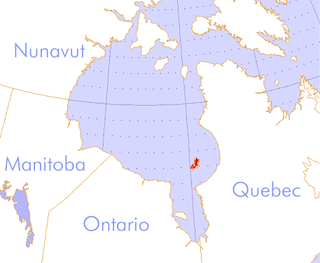
The Belcher Islands are an archipelago in the southeast part of Hudson Bay near the centre of the Nastapoka arc. The Belcher Islands are spread out over almost 3,000 km2 (1,200 sq mi). Administratively, they belong to the Qikiqtaaluk Region of Nunavut, Canada. The hamlet of Sanikiluaq is on the north coast of Flaherty Island and is the southernmost in Nunavut. Along with Flaherty Island, the other large islands are Kugong Island, Tukarak Island, and Innetalling Island. Other main islands in the 1,500–island archipelago are Moore Island, Wiegand Island, Split Island, Snape Island and Mavor Island, while island groups include the Sleeper Islands, King George Islands, and Bakers Dozen Islands.

The Dorset was a Paleo-Eskimo culture, lasting from 500 BCE to between 1000 CE and 1500 CE, that followed the Pre-Dorset and preceded the Thule people (proto-Inuit) in the North American Arctic. The culture and people are named after Cape Dorset in Nunavut, Canada, where the first evidence of its existence was found. The culture has been defined as having four phases due to the distinct differences in the technologies relating to hunting and tool making. Artifacts include distinctive triangular end-blades, oil lamps made of soapstone, and burins.

Pyrophyllite is a phyllosilicate mineral composed of aluminium silicate hydroxide: Al2Si4O10(OH)2. It occurs in two forms (habits): crystalline folia and compact masses; distinct crystals are not known.

Stone carving is an activity where pieces of rough natural stone are shaped by the controlled removal of stone. Owing to the permanence of the material, stone work has survived which was created during our prehistory or past time.

The chlorites are the group of phyllosilicate minerals common in low-grade metamorphic rocks and in altered igneous rocks. Greenschist, formed by metamorphism of basalt or other low-silica volcanic rock, typically contains significant amounts of chlorite.

Ultramafic rocks are igneous and meta-igneous rocks with a very low silica content, generally >18% MgO, high FeO, low potassium, and are composed of usually greater than 90% mafic minerals. The Earth's mantle is composed of ultramafic rocks. Ultrabasic is a more inclusive term that includes igneous rocks with low silica content that may not be extremely enriched in Fe and Mg, such as carbonatites and ultrapotassic igneous rocks.

Serpentinite is a metamorphic rock composed predominantly of one or more serpentine group minerals formed by near to complete serpentinization of mafic to ultramafic rocks. Its name originated from the similarity of the texture of the rock to that of the skin of a snake. Serpentinite has been called serpentine or serpentine rock, particularly in older geological texts and in wider cultural settings.

Dimension stone is natural stone or rock that has been selected and finished to specific sizes or shapes. Color, texture and pattern, and surface finish of the stone are also normal requirements. Another important selection criterion is durability: the time measure of the ability of dimension stone to endure and to maintain its essential and distinctive characteristics of strength, resistance to decay, and appearance.
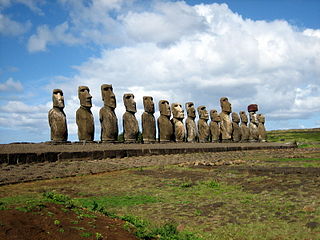
A stone sculpture is an object made of stone which has been shaped, usually by carving, or assembled to form a visually interesting three-dimensional shape. Stone is more durable than most alternative materials, making it especially important in architectural sculpture on the outside of buildings.

Inuit art, also known as Eskimo art, refers to artwork produced by Inuit, that is, the people of the Arctic previously known as Eskimos, a term that is now often considered offensive. Historically, their preferred medium was walrus ivory, but since the establishment of southern markets for Inuit art in 1945, prints and figurative works carved in relatively soft stone such as soapstone, serpentinite, or argillite have also become popular.

Asbestos is a naturally occurring fibrous silicate mineral. There are six types, all of which are composed of long and thin fibrous crystals, each fibre being composed of many microscopic "fibrils" that can be released into the atmosphere by abrasion and other processes. Inhalation of asbestos fibres can lead to various dangerous lung conditions, including mesothelioma, asbestosis, and lung cancer. As a result of these health effects, asbestos is considered a serious health and safety hazard.

Beer Quarry Caves is a man-made limestone underground complex located about a mile west of the village of Beer, Devon, and the main source in England for beer stone. The tunnels resulted from 2,000 years of quarrying beer stone, which was particularly favoured for cathedral and church features such as door and window surrounds because of its colour and workability for carving. Stone from the quarry was used in the construction of several of southern England's ancient cathedrals and a number of other important buildings as well as for many town and village churches, and for some buildings in the United States. Extraction was particularly intense during the Middle Ages, but continued until the 1920s. An adit to another set of workings can be seen from the South West Coast Path east of Branscombe, having been exposed by a landslip in the late 18th century. The quarry is part of the Jurassic Coast, and is a Site of Special Scientific Interest (SSSI).

Hardstone carving, in art history and archaeology, is the artistic carving of semi-precious stones, such as jade, rock crystal, agate, onyx, jasper, serpentinite, or carnelian, and for objects made in this way. Normally the objects are small, and the category overlaps with both jewellery and sculpture. Hardstone carving is sometimes referred to by the Italian term pietre dure; however, pietra dura is the common term used for stone inlay work, which causes some confusion.
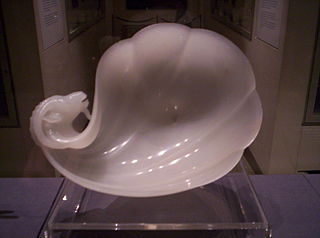
Hardstone is a non-scientific term, mostly encountered in the decorative arts or archaeology, that has a similar meaning to semi-precious stones, or gemstones. Very hard building stones, such as granite, are not included in the term in this sense, but only stones which are fairly hard and regarded as attractive – ones which could be used in jewellery. Hardstone carving is the three-dimensional carving for artistic purposes of semi-precious stones such as jade, agate, onyx, rock crystal, sard or carnelian, and a general term for an object made in this way. Two-dimensional inlay techniques for floors, furniture and walls include pietre dure, opus sectile, and medieval Cosmatesque work – these typically inlay hardstone pieces into a background of marble or some other building stone.

Catpund is a quarry site in Shetland, Scotland, where steatite vessels were cut from the rock from prehistory onwards. The quarrying marks are still visible today.

Qajartalik is a petroglyph site located on the Qajartalik peninsula of Qikertaaluk Island, Nunavut, approximately 40 km southeast of Kangiqsujuaq, Quebec. The site consists of over 150 carvings of faces in soapstone. It was created by the Dorset people, the culture who inhabited the Canadian eastern Arctic and Greenland beginning approximately 2,200 years ago before disappearing approximately 1,000 years ago, and who inhabited the region prior to the Thule Inuit who arrived approximately 800 years ago. It is believed to be the northernmost rock art site in North America and is considered to be one of a kind. The site is currently on Canada's tentative list of sites proposed for inscription on the UNESCO World Heritage List.
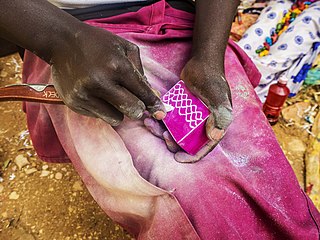
In the Kisii region in Kenya, soapstone is mined in the town of Tabaka. It has been at the heart of industry and culture, with its malleability allowing for the carving of a variety of items ranging from common household items to ornaments and other décor items, all of which have found their way into the commercial space, birthing the aforementioned 'industry' around the mining and processing of the ore – largely centered in Tabaka. In its finely milled form, soapstone has been found to have various commercial uses outside carving.


